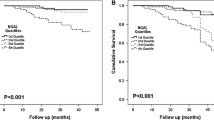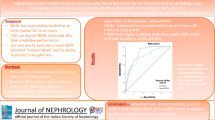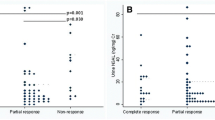Abstract
Background
The aim of this study was to examine whether plasma neutrophil gelatinase-associated lipocalin (NGAL) levels predict the outcome of kidney function and correlate with the severity of tubulointerstitial damages in patients with chronic kidney disease (CKD).
Methods
In this prospective 18-month cohort study of 112 patients with CKD between 2010 and 2011, associations between plasma NGAL levels and estimated glomerular filtration ratio (eGFR), further worsening of kidney function and histological lesion on kidney biopsy were investigated.
Results
Serum levels of creatinine and eGFR before the study were 1.48 ± 0.65 mg/dl and 42.6 ± 22.0 ml/min/1.73 m2. Median plasma NGAL level was 148.5 (83.75–248.25) ng/ml and showed no correlation with eGFR or age. 87 out of 112 patients were able to follow up for 18 months. Patients with higher levels of NGAL (>107.8 ng/ml) showed significantly more decrease in eGFR in CKD stage 1 or 2 than those with lower levels of NGAL (≦107.8 ng/ml), while there was no difference in change in eGFR in CKD stage 3–5 between patients with higher and lower levels of NGAL. In the kidney biopsy of 27 patients out of enrolled patients, plasma NGAL levels correlated significantly with the degree of interstitial cell infiltration and fibrosis, but did not correlate with that of glomerular sclerosis. In ROC analysis, plasma NGAL levels predicted tubulointerstitial cell infiltrations more accurately [AUC = 0.8300 than eGFR (AUC = 0.716)].
Conclusion
Plasma NGAL is a useful marker of interstitial lesions in patients with CKD and a predictor of further kidney worsening in the early CKD stage.





Similar content being viewed by others
References
Eddy AA, Neilson EG. Chronic kidney disease progression. J Am Soc Nephrol. 2006;17:2964–6.
Nickolas TL, O’Rourke MJ, Yang J, Sise ME, Canetta PA, Barasch N, et al. Sensitivity and specificity of a single emergency department measurement of urinary neutrophil gelatinase-associated lipocalin for diagnosing acute kidney injury. Ann Intern Med. 2008;148:810–9.
Paragas N, Qiu A, Zhang Q, Samstein B, Deng SX, Schmidt-Ott KM, et al. The Ngal reporter mouse detects the response of the kidney to injury in real time. Nat Med. 2011;17:216–22.
Haase M, Devarajan P, Haase-Fielitz A, Bellomo R, Cruz DN, Wagener G, et al. The outcome of neutrophil gelatinase-associated lipocalin-positive subclinical acute kidney injury a multicenter pooled analysis of prospective studies. J Am Coll Cardiol. 2011;57:1752–61.
Bolignano D, Lacquaniti A, Coppolino G, Donato V, Campo S, Fazio MR, et al. Neutrophil gelatinase-associated lipocalin (NGAL) and progression of chronic kidney disease. Clin J Am Soc Nephrol. 2009;4:337–44.
Malyszko J, Malyszko JS, Bachorzewska-Gajewska H, Poniatowski B, Dobrzycki S, Mysliwiec M. Neutrophil gelatinase-associated lipocalin is a new and sensitive marker of kidney function in chronic kidney disease patients and renal allograft recipients. Transplant Proc. 2009;41:158–61.
Liu KD, Yang W, Anderson AH, Feldman HI, Demirjian S, Hamano T, et al. Chronic Renal Insufficiency Cohort (CRIC) study investigators: urine neutrophil gelatinase–associated lipocalin levels do not improve risk prediction of progressive chronic kidney disease. Kidney Int. 2013;83:909–14.
Kuwabara T, Mori K, Mukoyama M, Kasahara M, Yokoi H, Saito Y, et al. Urinary neutrophil gelatinase-associated lipocalin level reflect damage to glomeruli, proximal tubules, and distal nephrons. Kidney Int. 2009;75:285–94.
Nickolas TL, Forster CS, Sise ME, Barasch N, Solá-Del Valle D, Viltard M, et al. NGAL (Lcn2) monomer is associated with tubulointerstitial damage in chronic kidney disease. Kidney Int. 2012;82:718–22.
Doi K, Urata M, Katagiri D, Inamori M, Murata S, Hisagi M, et al. Plasma neutrophil gelatinase-associated lipocalin in acute kidney injury superimposed on chronic kidney disease after cardiac surgery: a multicenter prospective study. Crit Care. 2013;17:R270.
Ronco C, Cruz D, Noland BW. Neutrophil gelatinase-associated lipocalin curve and neutrophil gelatinase-associated lipocalin extended-range assay: a new biomarker approach in the early diagnosis of acute kidney injury and cardio-renal syndrome. Semin Nehprol. 2012;32:121–8.
Inaguma D, Imai E, Takeuchi A, Ohashi Y, Watanabe T, Nitta K, Akizawa T, Matsuo S, Makino H, Hishida A. Chronic Kidney Disease Japan Cohort Study Group. Risk factors for CKD progression in Japanese patients: findings from the Chronic Kidney Disease Japan Cohort (CKD-JAC) study. Clin Exp Nephrol. 2016. doi:10.1007/s10157-016-1309-1.
Nohara N, Io H, Matsumoto M, Furukawa M, Okumura K, Nakata J, Shimizu Y, Horikoshi S, Tomino Y. Predictive factors associated with increased progression to dialysis in early chronic kidney disease (stage 1–3) patients. Clin Exp Nephrol. 2016;20:740–7.
Chang WX, Arai S, Tamura Y, Kumagai T, Ota T, Shibata S, Fujigaki Y, Shen ZY, Uchida S. Time-dependent risk factors associated with the decline of estimated GFR in CKD patients. Clin Exp Nephrol. 2016;20:58–70.
Mishra J, Dent C, Tarabishi R, Mitsnefes MM, Ma Q, Kelly C, Ruff SM, Zahedi K, Shao M, Bean J, Mori K, Barasch J, et al. Neutrophil gelatinase-associated lipocalin (NGAL) as a biomarker for acute renal injury after cardiac surgery. Lancet. 2005;365:1231–8.
Wagener G, Gubitosa G, Wang S, Borregaard N, Kim M, Lee HT. Urinary neutrophil gelatinase-associated lipocalin and acute kidney injury after cardiac surgery. Am J Kidney Dis. 2008;52:425–33.
Bolignano D, Coppolino G, Campo S, Aloisi C, Nicocia G, Frisina N, et al. Urinary neutrophil gelatinase-associated lipocalin (NGAL) is associated with severity of renal disease in proteinuric patients. Nephrol Dial Transplant. 2008;23:414–6.
Bolignano D, Coppolino G, Campo S, Aloisi C, Nicocia G, Frisina N, et al. Neutrophil gelatinase-associated lipocalin in patients with autosomal-dominant polycystic kidney disease. Am J Nephrol. 2007;27:373–8.
Mori K, Nakao K. Neutorophil gelatinase-associated lipocalin as the real-time indicator of active kidney damage. Kidney Int. 2007;71:967–70.
Author information
Authors and Affiliations
Corresponding author
Ethics declarations
Conflict of interest
The authors have declared that no conflict of interest exists.
Ethical approval
All procedures performed in studies involving human participants were in accordance with the ethical standards of the institutional research committee at which the studies were conducted (IRB Approval No. TGE00115-024) and with the 1964 Helsinki Declaration and its later amendments or comparable ethical standards.
Informed consent
Informed consent was obtained from all individual participants included in the study.
About this article
Cite this article
Moriya, H., Mochida, Y., Ishioka, K. et al. Plasma neutrophil gelatinase-associated lipocalin (NGAL) is an indicator of interstitial damage and a predictor of kidney function worsening of chronic kidney disease in the early stage: a pilot study. Clin Exp Nephrol 21, 1053–1059 (2017). https://doi.org/10.1007/s10157-017-1402-0
Received:
Accepted:
Published:
Issue Date:
DOI: https://doi.org/10.1007/s10157-017-1402-0




